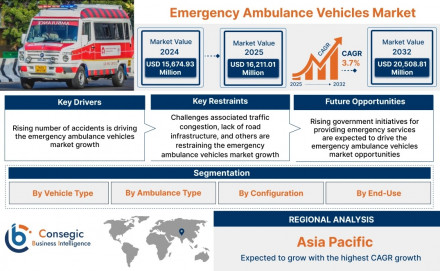Emergency Ambulance Vehicles Market: Applications and Demand (2025-2032)

Emergency Ambulance Vehicles Market Size:
Emergency Ambulance Vehicles Market size is estimated to reach over USD 20,508.81 Million by 2032 from a value of USD 15,674.93 Million in 2024 and is projected to grow by USD 16,211.01 Million in 2025, growing at a CAGR of 3.7% from 2025 to 2032.
Emergency Ambulance Vehicles Market Overview:
The global emergency ambulance vehicles market is witnessing significant growth due to increasing investments in healthcare infrastructure, advancements in automotive and medical technologies, and the growing need for efficient emergency response systems. Both public and private sectors are enhancing their fleets with technologically advanced ambulances, including types such as Basic Life Support (BLS) and Advanced Life Support (ALS) units. Additionally, mobile ICUs and air ambulances are gaining popularity in developed regions. The market includes a range of vehicles from vans and trucks to custom-built emergency medical vehicles.
Emergency Ambulance Vehicles Market Includes Drivers, Restraints & Opportunities
Key Drivers:
- Rising incidence of accidents and medical emergencies: Increasing road accidents, natural disasters, and sudden medical conditions such as cardiac arrests are propelling the demand for rapid emergency transportation.
- Government initiatives and healthcare funding: Many governments are investing heavily in improving EMS infrastructure, which includes modernizing ambulance fleets.
- Technological advancements: The integration of telemedicine, GPS, AI-assisted navigation, and real-time patient monitoring systems in ambulances is enhancing efficiency and safety.
- Growing geriatric population: Older adults require frequent medical attention and emergency care, which drives the demand for ambulance services.
Key Restraints:
- High cost of advanced ambulances: Equipping ambulances with advanced life support systems and technology significantly increases costs, posing a challenge for developing regions.
- Lack of standardization and skilled personnel: Inconsistent regulations across regions and the shortage of trained paramedics limit the optimal utilization of emergency vehicles.
- Maintenance and operational challenges: Regular maintenance, fuel costs, and the need for round-the-clock readiness can burden EMS providers, especially in rural or underfunded areas.
Future Opportunities:
- Expansion in developing regions: Countries in Asia-Pacific, Latin America, and Africa are witnessing improvements in healthcare infrastructure, creating demand for emergency ambulance fleets.
- Integration with telemedicine and IoT: The adoption of connected vehicle technology and digital health tools provides opportunities for remote patient diagnostics and care during transport.
- Electrification and green ambulances: The push toward sustainable transportation has prompted the development of electric and hybrid ambulances, opening a new market segment.
- Public-private partnerships (PPPs): Collaborations between government and private players can facilitate large-scale fleet upgrades and EMS expansion.
Emergency Ambulance Vehicles Market Competitive Landscape Analysis (Key Players)
- Babcock International Group PLC (UK)
- London Ambulance Service NHS Trust (UK)
- Air Methods Corporation (US)
- Ziqitza Healthcare Limited (India)
- Medivic Pharmaceutical PVT LTD. (India)
- Acadian Ambulance Service (US)
- BVG (India)
- America Ambulance Service, Inc. (US)
- Falck A/S (Denmark)
- Global Medical Response (US)
Emergency Ambulance Vehicles Market Industry Segmentation:
By Vehicle Type
- Vans
- Cars
- Others
By Ambulance Type
- Ground Ambulance
- Basic Life Support Ambulance
- Advanced Life Support Ambulance
- Intensive Care Unit Ambulance
- Air Ambulance
- Helicopters
- Fixed-Wing ambulances
- Water Ambulance
By Configuration
- Type 1
- Type 2
- Type 3
By End-Use
- Hospitals
- Emergency Centers
- Others
By Region
- Asia-Pacific
- Europe
- North America
- Latin America
- Middle East & Africa
Regional Analysis of the Emergency Ambulance Vehicles Market:
- North America: The region leads the global market, driven by advanced healthcare systems, government funding, and widespread EMS coverage. The U.S. has a mature ambulance services infrastructure and high ambulance-to-population ratio.
- Europe: Countries like Germany, the UK, and France are investing in upgrading EMS fleets. The European market is characterized by a focus on green mobility and compliance with stringent emission norms.
- Asia-Pacific: The fastest-growing region, with rapid urbanization, increasing health awareness, and rising government healthcare expenditure. India, China, and Japan are key contributors to market growth.
- Latin America: Moderate growth supported by public health initiatives and rising urban populations. Brazil and Mexico are major markets.
- Middle East & Africa: Growth is driven by improvements in emergency services, especially in GCC countries. However, access remains limited in some remote areas.
Emergency Ambulance Vehicles Market Recent Developments:
- Mercedes-Benz Vans launched a next-generation Sprinter-based ambulance with enhanced safety and telematics features.
- Ford Pro Ambulance Prep Package was introduced to allow customization of E-Series cutaways for EMS usage.
- REV Group expanded its portfolio with electric ambulance platforms, aimed at sustainability in EMS operations.
- Frazer Ltd. partnered with several municipalities in the U.S. to deliver modular ambulance units with integrated HVAC and patient safety features.
- BharatBenz (India) entered the market with locally manufactured ambulances meeting national health mission specifications.
Contact us:
Consegic Business intelligence Pvt Ltd.
Contact no: (US) (505) 715-4344
Email: sales@consegicbusinessintelligence.com

